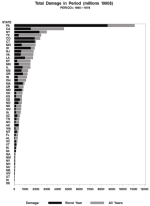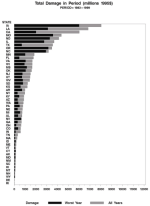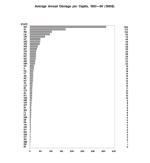
|
|
|
|
|
|
|
|
|
|
|
|
|
|
|
|
|
|
|
|
|
|
|
|
|
Flood Damage in the United States, 1926-2003 7. Use and Interpretation of NWS Flood Damage Data "Estimate" is the key word for describing the NWS flood damage data. They do not represent an accurate accounting of actual costs, nor do they include all of the losses that might be attributable to flooding. Rather, they are rough estimates of direct physical damage to property, crops, and public infrastructure. Damage estimates for individual flood events are often quite inaccurate, but as estimates from many events are added together the errors become proportionately smaller. These findings suggest that, at the national level, annual damage totals are reasonably accurate because they are sums of damage estimates from many flood events. Flood damage occurs every year, and the frequency distribution of national damages during 1934-1999 approximates a log normal distribution. Therefore, the national data can be analyzed using conventional parametric statistics. State annual damage estimates are more problematic. Both frequency and magnitude of damage must be considered, because damaging floods do not occur every year in most states. Flood frequency cannot be determined simply by the presence or absence of a damage estimate because reporting, particularly for small floods, is unreliable. (To estimate flood frequency, we recommend establishing a threshold below which estimates are simply classified as "low" or "minimal", as in Section 6.) Estimates of the magnitude of annual damage are often highly unreliable. In many states, most of the annual damage estimates are below $500 million (in inflation-adjusted 1995 dollars), therefore likely to contain proportionately large errors, as shown in Section 5. Even when damage is greater than $500 million, estimates from different sources have been found to disagree by as much as 40%. Aggregation is one key to reducing estimation errors. To compare flood damages between states or river basins, it is advisable to aggregate the damage estimates over many years and compare the sums. To compare damage between years, it is advisable to aggregate yearly state damage estimates over multi-state regions, or river basin damages over large river drainage systems. Even when the estimates are highly aggregated, the user still needs to be aware that some of the variability is caused by error, and interpret the results accordingly. A. Analyzing Trends Over Time There are several ways of looking at trends in flood damage. Economic damage results from an interaction between flood waters and human activities in the flooded area, so one must consider changes in population and development. Figure 7-1 shows (a) U.S. total flood damage, (b) flood damage per capita, and (c) flood damage per million dollars of tangible wealth6. (All estimates are adjusted for inflation.) The three graphs give quite different pictures of how U.S. flood damage has changed over time. Total damage and per capita damage show statistically significant increasing trends since 1934. On the other hand, damage per unit wealth has declined slightly, although the trend is not statistically significant (alpha = 0.05). Figure 7-1. Estimated annual flood damage in the United States, 1934-1999: (Click on thumbnail images to enlarge images.)
|
||||||||||||||||||
|
Caution #1: In analyzing flood damage over time, it is important to control for changes in population, wealth, or development. B. Comparing States Comparing states on the basis of their historical flood damage is complicated by the rarity of extreme damage. In a limited time period of study, some states will have experienced a low-probability flood event and others will not. Damage totals for the period depend greatly on a few extreme events. Although aggregating state damage estimates over many years helps reduce estimation errors, it does not account for differences in the timing of severe damage. For example, the inclusion of data for just one more year, 1979, would change the position of Texas in the ranking of total damages in Figure 6-2, moving it from 6th to 3rd place (Section 6). Figures 7-2(a, b) compare rankings of the states based on their total flood damage in two periods, 1955-1978 and 1983-1999. Pennsylvania suffered the greatest damage in the earlier period, but its rank slips to 26th in the later period. Iowa moves in the opposite direction, from 28th in the earlier period to first in the later period. In both states, a single flood event determines the first-ranked status. A single year constitutes the majority of damage in many other states, as well. Differences in the timing and location of extreme weather events contribute to quite different rankings during the two periods. Population differences are also an important factor when comparing states. In Figure 7-3, states are ranked according to their annual average damage per capita during 1983-1999, giving a quite different picture than the ranking by total damage in Figure 7-2(b). North Dakota moves to the top, with a whopping $363 damage per person per year (mostly attributable to flooding in 1997), while California slips to 25th place. Caution #2: When comparing damage in different geographical areas, it is important to control for differences in population and in the incidence of extreme weather events during the period of study. C. Comparing Individual Flood Events In comparing annual state estimates, we recommend coarse comparisons using broad damage categories, perhaps similar to those used in Section 5 (low, medium, high, major)7. Uncertainty in the dollar estimates can make comparisons difficult, even in major floods where estimates are highly aggregated. Some of the difficulties are illustrated by the following comparison of two years of major flood damage (over $500 million) in Minnesota in the 1990s. Figure 7-2. States ranked based on total flood damage: (Click on thumbnail images to enlarge images.)
|
||||||||||||||||||
|
Figure 7-3. States ranked based on average annual flood damage per capita, 1983-1999: (Click on thumbnail image to enlarge image.)
|
||||||||||||||||||
|
1993: Unusually heavy rainfall from May through August over most of the state produced widespread flooding that resulted in a presidential disaster declaration for 57 of Minnesota's 87 counties, and an agricultural disaster declaration for an additional eight counties. The NWS estimated damage of $1.0 billion (in 1995 dollars). 1997: Heavy snow and ice followed by spring rains and rapid snowmelt led to severe flooding in April and May. Damage was extensive in East Grand Forks and many smaller communities. A presidential disaster declaration was issued covering 58 Minnesota counties. Additional storms and flooding in June and July led to another disaster declaration for 7 metropolitan area counties. The NWS estimated damage of $715 million (in 1995 dollars). In which year was the damage more severe? The answer to this question depends upon how "severe" is defined. The NWS estimates suggest that damage was substantially greater in 1993. However, a report issued by the Minnesota Department of Public Safety leads to the opposite conclusion. Table 7-1 shows actual costs reported in A Decade of Minnesota Disasters (MDPS 2000). (We have excluded costs that are not associated with direct damage, such as temporary housing, hazard mitigation, and economic injury due to loss of business.) FEMA assistance programs, insurance, and SBA loans all indicate that non-agricultural losses were much higher in 1997 than in 1993. A representative of Minnesota's Division of Emergency Management reinforced this conclusion, telling us that in 1997 entire Minnesota towns were flooded, while in 1993 the main effects of the great Midwest flood occurred in states farther south (Sherrill Neudahl, personal communication, 10/5/00). Agricultural damage was greater in 1993 than in 1997, however. The value of Minnesota's final crop output in 1993 was 44% less than the average of the previous three years (USDA 2000). In contrast, final crop output in 1997 was equal to the average for the previous three years, suggesting that the floods did little to diminish agricultural productivity that year. Twice as much money was awarded in FSA loans to Minnesota farmers in 1993 as in 1997 (Table 7-1). Lumping agricultural and non-agricultural losses into a single damage estimate is problematic. Enormous discrepancies are found in historical estimates of agricultural damage because of different perspectives on and methodologies for the measurement of losses. For example, one official publication estimated that Minnesota's total damage in the 1993 flood exceeded $1.7 billion (MDPS 1994) - substantially more than the NWS estimate. Of that, $1.5 billion was attributed to crop "losses" based on the amount that crop production fell short of the previous 4-year average. This is a loss in expectation, perhaps, but not a loss of actual investment. This comparison does not lead us to challenge the NWS estimates for these two flood years. Rather, it provides another reason for caution in interpreting and comparing damage estimates. Given the error magnitudes found in Section 5, the difference of 40% in estimates for the two years is not large enough to say with confidence that one year's economic damage was worse than the other's, only that there was major damage in both years. Most Minnesotans would probably consider the floods of 1997 to be much more severe than those of 1993, while farmers might hold the opposite view. Table 7-1. Minnesota flood damage expenditures in major flood years 1993 and 1997 (in millions of 1995 dollars). Source: MDPS 2000.
|
||||||||||||||||||
|
* FEMA-993-DR-MN in 1993; FEMA-1175-DR-MN and FEMA-1158-DR-MN in 1997. Caution #3: Because of the large estimation errors found in the NWS data, estimates for individual floods should be used with caution. For some purposes the comparison of individual floods may be better done using nominal or ordinal data categorizations. For specific events, detailed descriptions should be sought to compare the nature and impacts of the damage. D. Possible Inconsistencies With Other Sources The NWS defines flood damage more narrowly than many other agencies. Emergency management agencies generally include both river and coastal flooding whenever water rises to overflow land that is not normally submerged. In contrast, the NWS estimates include only flooding whose primary cause is rainfall, snowmelt, or river flows, excluding flooding caused by wind-driven waves associated with coastal storms or hurricanes. For example, FEMA records show a Presidential disaster declaration of type "flood" for Massachusetts in February 1978, and the USACE reports $520 million flood damage due to storm surge and huge waves (USACE New England Division 1979; converted to 1995 dollars), but that damage is not included in NWS flood damage estimates. The NWS estimates do include floods caused by dam failure, however. In the NWS record, Idaho's worst flood resulted from the failure in 1976 of the newly-constructed Teton Dam, with damage estimates in the $1 - 2.3 billion range (in 1995 dollars). Idaho's largest estimated flood damage due to natural causes was much smaller: $120 million in 1997. Caution #4: Different agencies define "flood" and "flood damage" somewhat differently. Check for incompatibilities between data from different sources before seeking to combine sources or aggregate data. E. Uses of the Reanalyzed NWS Damage Estimates With the precautions noted above, we conclude that the reanalyzed NWS flood damage estimates can be a valuable tool to aid researchers and decision makers in understanding the changing character of damaging floods in the United States. Data sets of annual damage at national, state, and river basin levels are available in this website. In climate research, these data can contribute to understanding the relationship between climatic influences and damaging floods. For example, they have been used to examine the relationship of national and regional flood damage with several measures of precipitation, in a study that controlled for changes in population and wealth (Pielke and Downton 2000). For policy makers and emergency managers, the data provide a nationwide overview of flood vulnerability and can be useful in evaluating policies related to management of flood hazards. For example, we have investigated the role of politics in presidential disaster declaration decisions by comparing disaster declarations involving floods with estimated flood damage (Downton and Pielke 2001). F. Recommendations for Future Collection of Flood Damage Estimates A series of natural disasters in the 1990s, accompanied by skyrocketing costs of federal disaster assistance, has prompted calls for development of national databases to record losses from past and current disasters (Mileti 1999, NRC 1999, Heinz Center 2000). The NWS damage estimates are not reliable enough to be a basis for certain decisions regarding flood policy, such as setting specific flood insurance premiums or evaluating the cost-effectiveness of particular hazard mitigation measures. Better damage data are needed to evaluate the effectiveness of mitigation measures designed to reduce flood losses. Substantial improvement of flood damage records in the U.S. would require additional funding and should have a clear purpose based on intended uses of the data. A committee of the National Research Council (NRC) points out that reliable loss data are critical for cost-effective hazard mitigation and planning for future disaster response. The NRC (1999) report recommends measures for developing a comprehensive and consistent database of losses resulting from natural disasters. Recommendations include:
Clearly, the NWS flood damage database does not provide the level of accuracy and detail envisioned in the NRC recommendations, nor is it intended to do so. Nevertheless, the collection of damage information in severe weather events by NWS field offices provides a model, of sorts, for nationwide collection of damage data. It is administered fairly uniformly throughout the nation, collects information on multiple natural hazards, focuses on direct losses including some unreimbursed losses, and is not limited to declared disasters. As the NWS field offices collect storm damage information, they are in a good position to identify weather events that appear to meet whatever minimum criteria might be established for loss data to be compiled. In the absence of additional funding, only minor improvements can be expected in the NWS collection of flood damage estimates. The following modest changes are suggested to improve accuracy, consistency, and usefulness.
|

A report of the University Corporation for Atmospheric Research, supported by the National Science Foundation, the National Weather Service, and the National Oceanic and Atmospheric Administration, Office of Global Programs, pursuant to NOAA Award No. NA96GP0451 through a cooperative agreement. In partnership between the Environmental and Societal Impacts Group of the National Center for Atmospheric Research and the Center for Science and Technology Policy Research, Cooperative Institute for Research in Environmental Sciences, University of Colorado.
A report of the University Corporation for Atmospheric Research, supported by the National Science Foundation, the National Weather Service, and the National Oceanic and Atmospheric Administration, Office of Global Programs, pursuant to NOAA Award No. NA96GP0451 through a cooperative agreement. In partnership between the Environmental and Societal Impacts Group of the National Center for Atmospheric Research and the Center for Science and Technology Policy Research, Cooperative Institute for Research in Environmental Sciences, University of Colorado.




